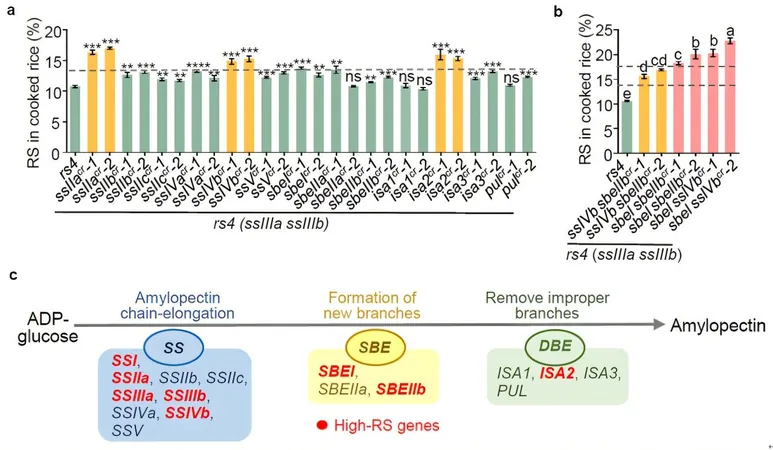
Breakthrough in Rice Science: Researchers Develop High-Resistant Starch Rice That Could Transform Health!
2024-11-25
Author: Michael
Rice is a staple food for billions around the globe, but did you know that it also harbors the potential to revolutionize nutrition? Researchers have made an incredible advancement in creating rice with high levels of resistant starch (RS), a type of starch known for its health benefits, including improved blood sugar control, weight management, and reduced risk of inflammatory bowel diseases.
While most traditional rice varieties offer a modest RS content of less than 2% once cooked, a new study reveals that genetic modifications can push this number drastically higher. A dedicated team led by Wang Anqi at the Institute of Genetics and Developmental Biology, part of the prestigious Chinese Academy of Sciences, has successfully manipulated specific amylopectin biosynthetic genes, leading to remarkable increases in RS levels in rice.
Published on November 19 in the Plant Biotechnology Journal, their research—the title revealing its groundbreaking nature as "Creation of high-resistant starch rice through systematic editing of amylopectin biosynthetic genes in rs4"—shows promising results. According to Prof. Li Jiayang, one of the senior researchers, "Elucidating the mechanism of RS biosynthesis has important theoretical and practical significance for improving the nutritional value of rice."
Prior investigations showed that modifications to the ssIIIa and ssIIIb single and double mutants could elevate RS content significantly—from 2% to an impressive 6% and 10%, respectively. In their latest endeavor, the team employed genome editing techniques to systematically examine 14 biosynthetic genes, resulting in quadruple mutants of sbeI sbeIIb ssIIIa ssIIIb and sbeI ssIVb ssIIIa ssIIIb that pushed RS levels beyond 18%!
However, there's a catch! The quest for higher RS levels is not without its challenges. The study revealed a trade-off: as RS content increased, both the eating quality of cooked rice and overall grain yield were compromised. Nevertheless, the ssIIIa ssIIIb mutants demonstrated a balance between RS content and grain yield, paving the way for future research to find solutions that meet both health and agricultural demands.
This breakthrough could mark a significant leap in addressing global health issues related to diet, obesity, and metabolic disorders. As researchers continue to fine-tune these genetic modifications, the dream of nutritious rice that supports health and wellness could soon become a reality! Are we ready to embrace this new era of super rice? The future of food may be just around the corner!









 Brasil (PT)
Brasil (PT)
 Canada (EN)
Canada (EN)
 Chile (ES)
Chile (ES)
 España (ES)
España (ES)
 France (FR)
France (FR)
 Hong Kong (EN)
Hong Kong (EN)
 Italia (IT)
Italia (IT)
 日本 (JA)
日本 (JA)
 Magyarország (HU)
Magyarország (HU)
 Norge (NO)
Norge (NO)
 Polska (PL)
Polska (PL)
 Schweiz (DE)
Schweiz (DE)
 Singapore (EN)
Singapore (EN)
 Sverige (SV)
Sverige (SV)
 Suomi (FI)
Suomi (FI)
 Türkiye (TR)
Türkiye (TR)